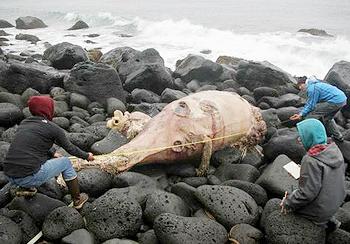
LA JOLLA, California, July 31, 2016 (ENS) – Scientists have identified a beaked whale that lives in the cold and remote North Pacific Ocean as a new species.
They have yet to officially name the whale, but have confirmed the species as a member of the genus Berardius.
Scientists from the United States, Russia, Australia and France searched museums and other sources for DNA samples to verify the existence of the new whale, which is smaller and darker in color than the more common Baird’s beaked whale.
“The challenge in documenting the species was simply locating enough specimens to provide convincing evidence,” said Morin. “Clearly this species is very rare, and reminds us how much we have to learn about the ocean and even some of its largest inhabitants.”

Described in an article published in the current issue of the journal “Marine Mammal Science,” the new species is an elusive, deep-diving whale about 25 feet long that is rarely seen. Only eight examples of the new species have ever been found. The majority originate from an area around northern Japan, the rest are from the Aleutian Islands and the Bering Sea.
“Every known specimen of this new whale found so far has been dead and, in most cases, decomposing on a remote sub-arctic beach,” said lead author Dr. Phillip Morin.
“Without a full skeleton of an adult animal or detailed measurements, we had to use forensic genetics to describe the evolutionary differences of this new species,” said Morin, who works with the Marine Mammal and Turtle Division, Southwest Fisheries Science Center, National Marine Fisheries Service, NOAA, and the Scripps Institution of Oceanography, both in La Jolla, California.
“As much as we know about the genetic heritage of this animal,” Morin said, “we still do not know very much about the animal itself. We can draw some indications from what we know about other beaked whales in terms of its range and behavior, but we still have many more questions than answers.”
People who spotted a decomposing 24-foot cetacean on a St. George Island beach in June 2014 tipped off scientists, took tissue samples, and later helped to track its location for months as Bering Sea storms rolled the huge carcass along the coast.

The scientists worked with high school students and other residents of the tiny island inhabited by just 100 people, one of the Pribilof Islands off the western coast of Alaska in the United States.
Co-author Erich Hoyt, is co-director of the Russian Cetacean Habitat Project, which contributed genetic samples from beaked whales in the Russian Far East.
Hoyt explains that the DNA analysis shows the new species and Baird’s beaked whale are each more closely related to Arnoux’s beaked whale from the Southern Hemisphere than they are to each other.
“Japanese whalers have known about the black form but didn’t consider it a separate species,” said Hoyt, who is also a research fellow with the UK charity Whale and Dolphin Conservation and co-chair of the IUCN Marine Mammal Protected Areas Task Force.
“The implication of a new species of beaked whale is that we need to reconsider management of both species to be sure they’re sufficiently protected, considering how rare the new one appears to be,” Hoyt said.
Beaked whales are the members of the family Ziphiidae, which consists of 22 species. These toothed whales are notable for their elongated beaks, similar to those of many dolphins.
Beaked whales are medium size, ranging from four to 13 metres (13 to 43 ft) and weighing from one to 15 tonnes. Individual species are difficult to identify in the wild, since body form varies little; the distinguishing marks are subtle differences in size, color, forehead shape, and beak length.
Among air-breathing animals, beaked whales are some of the most extreme divers – the longest and deepest foraging dive recorded is 137.5 minutes at 9,816 feet (2,992 meters). This is the greatest dive-depth known for a mammal.
A serious conservation concern for all beaked whales is their vulnerability to modern sonar operations – recent strandings coincide with naval sonar exercises. According to a study published in 2007 in “Marine Mammal Science,” post mortem examinations of these stranded whales have reported hemorrhaging near the ears.
Hoyt said, “Discovering a new species of whale in 2016 is exciting, but it also reveals how little we know and how much more work we have to do to truly understand these species.”
Copyright Environment News Service (ENS) 2016. All rights reserved.
